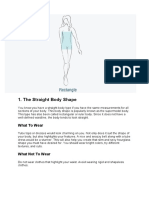0 ratings0% found this document useful (0 votes)
144 viewsSkin Tone
Skin Tone
Uploaded by
KISHThis document provides methods for determining skin tone and recommendations for makeup, clothing, and accessories based on whether someone has cool, warm, or neutral undertones. It describes examining the color of veins on the wrist, how skin reacts to the sun, holding white paper to the face, using gold or silver jewelry, and asking a friend to examine skin behind the ear to determine undertones. It then offers lipstick, blush, eyeshadow, and clothing color suggestions tailored to different undertones and skin depths.
Copyright:
© All Rights Reserved
Available Formats
Download as PPTX, PDF, TXT or read online from Scribd
Skin Tone
Skin Tone
Uploaded by
KISH0 ratings0% found this document useful (0 votes)
144 views25 pagesThis document provides methods for determining skin tone and recommendations for makeup, clothing, and accessories based on whether someone has cool, warm, or neutral undertones. It describes examining the color of veins on the wrist, how skin reacts to the sun, holding white paper to the face, using gold or silver jewelry, and asking a friend to examine skin behind the ear to determine undertones. It then offers lipstick, blush, eyeshadow, and clothing color suggestions tailored to different undertones and skin depths.
Original Title
SKIN TONE
Copyright
© © All Rights Reserved
Available Formats
PPTX, PDF, TXT or read online from Scribd
Share this document
Did you find this document useful?
Is this content inappropriate?
This document provides methods for determining skin tone and recommendations for makeup, clothing, and accessories based on whether someone has cool, warm, or neutral undertones. It describes examining the color of veins on the wrist, how skin reacts to the sun, holding white paper to the face, using gold or silver jewelry, and asking a friend to examine skin behind the ear to determine undertones. It then offers lipstick, blush, eyeshadow, and clothing color suggestions tailored to different undertones and skin depths.
Copyright:
© All Rights Reserved
Available Formats
Download as PPTX, PDF, TXT or read online from Scribd
Download as pptx, pdf, or txt
0 ratings0% found this document useful (0 votes)
144 views25 pagesSkin Tone
Skin Tone
Uploaded by
KISHThis document provides methods for determining skin tone and recommendations for makeup, clothing, and accessories based on whether someone has cool, warm, or neutral undertones. It describes examining the color of veins on the wrist, how skin reacts to the sun, holding white paper to the face, using gold or silver jewelry, and asking a friend to examine skin behind the ear to determine undertones. It then offers lipstick, blush, eyeshadow, and clothing color suggestions tailored to different undertones and skin depths.
Copyright:
© All Rights Reserved
Available Formats
Download as PPTX, PDF, TXT or read online from Scribd
Download as pptx, pdf, or txt
You are on page 1of 25
SKIN TONE
How to Determine Skin Tone
Your skin tone, also called undertone, is different from
your complexion, which is the shade of your skin (light,
medium, dark). Your undertone will remain the same no matter
how much sun you get, even if you’re pale in the winter and
tan in the summer. There are three different undertones - cool,
warm, and neutral.[1]
Knowing your skin tone can be helpful in many ways--it
can help you choose the right lipstick color, figure out which
hair color is most flattering, and know which
colors you should wear to really look like a knock out
Method 1
Finding Your Undertones
1. Wash your face, then wait 15
minutes. Your skin should be clean and
free of makeup, lotion, or toner. Your skin
needs to rest for about 15 minutes before
proceeding, as your skin may appear pink
from scrubbing and make it difficult to see
your true undertone.
2. Find a natural light
source. Different light bulbs can
affect your skin differently--they
may give it a yellow or green cast,
and interfere with the appearance of
your skin tone. Choosing a sunny
spot to look for your undertones
will prevent you from misjudging
your undertones. Try sitting next to
a window.
If you have an outdoor seating area,
go outside.
3. Look at the color of the veins
on the inside of your wrist. This
is a quick way to determine your
undertones if your veins are
visible. Hold up your arm in the
natural light and determine the
predominant color.[2]If you can't
tell if your veins are green or blue,
you may have a neutral skin tone.
If you have an olive complexion,
you likely fall into this category.[3]
If your veins appear green, you
have a warm skin tone.[4]
If your veins appear blue or purple,
you have a cool skin tone.[5]
4. Consider how your skin
normally reacts to the sun. Do
you tan easily? Do you burn or get
freckles? The amount of melanin in
your skin determines how it reacts
to sun exposure and can help you
determine your skin tone.[6]If you
tan easily and rarely burn, you have
more melanin and you likely have a
warm or neutral skin tone.[7]
If your skin burns and doesn't tan,
you have less melanin and therefore
a cooler skin tone.[8]
Some women with very dark, ebony
skin may not burn easily but still
have a cool skin tone. Try a few
more tests to figure out your
undertone.[9]
5. Hold a white piece of paper up to your
face. Looking in a mirror, try to see how your skin
looks in contrast to the white paper. It may appear to
have a yellow cast, a blue-red or rosy cast, or it may
not appear to be either, but a gray color instead.If
your skin appears yellowish or sallow beside the
white paper, you have a warm skin tone.
If your skin appears pink, rosy, or blueish-red, then
you have a cool skin tone.
If your skin appears gray, your skin probably has an
olive complexion with a neutral undertone. The green
from your complexion and the yellowish undertone
combines to create this effect.[10] You can experiment
with neutral and warm tones, since you fall
somewhere in between.[11]
If you can't determine any cast of yellow, olive, or
pink, you have a neutral skin tone. Neutral tones can
look good in foundations and colors on both ends of
the cool/warm spectrum.[12]
6. Use gold and silver foil or jewelry to find
your skin tone. Hold a sheet of gold foil in
front of your face so that it reflects light back
on your skin. Note whether it makes your face
look grayish or washed out, or if it enhances
your skin. Then try with a sheet of silver foil. If
the gold foil looks best, you have a warm skin
tone.
If the reflection from the silver foil makes your
skin glow, you have a cool skin tone.
If you don't notice a difference (both silver and
gold are flattering), then you likely have a
neutral skin tone.[13]
If you don't have gold or silver foil, try laying
gold and silver jewelry on your wrist, and
notice which one is more flattering.[14]
7. Ask a friend to look at the skin behind
your ear. If you have acne, rosacea, or
another condition that might mask your skin
tone, you can have a friend look at the the
skin directly behind the shell of your ear, as
this area is less likely to be affected.Have
them examine the skin right in the little
crease behind your ear.
If your skin is yellowish, then your skin
tone is warm.
If your skin is pink or rosy, then your skin
tone is cool
If they have difficulty, they can try holding
a white piece of paper near the skin. That
should help them see if it appears yellow or
pink.
8. Look at your eye color. Your
eye color can be a key to your
undertones. Lighter eyes like
blue and pale brown usually
mean you have cool undertones,
while gold flecks usually
indicate warm undertones. For
example, ice blue eyes usually
mean you have cool skin, while
honey brown eyes usually mean
you have warm skin.
Method2
Choosing Your Lipstick
1. Try blue- or purple-shaded lipstick
colors if you have cool undertones. For
example, choose bluish-red, magenta pink,
or purplish-brown. Avoid oranges and
colors that are too pale because they can
wash you out.[15]If you have fair or light
skin, look for raspberry, mocha, or nudes,
especially.[16]
If you have olive or tan skin, look for wine
colored shades or cranberry.
If you have a dark or deep complexion,
look for metallic shades in ruby red or a
deep wine shade.[17]
2. Choose reds and orangey colors if you
have warm undertones. Great options
include corals, peaches, and bright reds.[18]
If you have fair or light skin, try red with
blue undertones (this will make your teeth
look very white, too), coral, pale pink or
peachy nudes.[19]
If you have tan or medium skin, go for
cherry red, rose, mauve, corals, or berry.
Try tangerine, orange-red, copper, or
bronze.[20]
If you have a dark or deep complexion,
look for browns, copper, bronze, purples,
caramel, plumb, or wine colored lipsticks.
[2
3. Play with color if you have
neutral tones. If you have
neutral undertones, most colors
will looks good on you. Try to
play up your complexion by
wearing darker, contrasting
colors if you have pale skin,
corals if you have olive or tan
skin, and berry colors if you
have dark skin.[22]
Method3
Selecting a Flattering Blush
1. Pick a shade of pink if you
have cool undertones. Pinks will
complement the pink, red, and
bluish hints in cool skin, bringing
your skin to life. If you have fair or
pale skin, try light pinks.[23]
If you have medium skin, try a
bright pink shade.[24]
If you have deep or dark skin, try a
berry shade.[25] You may also look
great in pink-tinted shades of
tangerine.[26]
2. Choose orange-based colors if you
have warm undertones. Rich, warm
colors like those typically used around
fall are your best bet for glowing
skin.If you have fair or pale skin, opt
for light peaches.[27] You can also try
bronze shades.[28]
If you have medium or tan skin, try
apricot, mauve, orange-peach, bronze,
or berry shades.[29]
If your skin is deep or dark, try brick
red, raisin, or tangerine.[30] Fuchsia can
also look great against your skin.[31]
3. Play with color if you have
neutral undertones. If you’re
lucky enough to have neutral
undertones, any shade of blush
could look great on your skin. Try
several shades to find out which
one you like best. If you have pale
skin, try pink shades.
If you have medium skin, start with
peachy colors.[32]
If you have dark skin, opt for deep,
rich colors.[33]
Method4
Choosing an Eyeshadow
1. Look for colors that add warmth if
you have cool undertones. If you go
too icy, you can look washed out.
Instead, add warmth to your features
without creating too much contrasts. If
you have pale skin, try sheer shades of
taupe, pinks, and greens.[34]
Try a pink or peach if you have medium
skin.[35]
If you have dark or deep skin, look for
bright shades like jewel tones that stand
out against our skin.[36]
2. Play up your warm
undertones with rich shades. If
you have warm undertones, bring
them alive with deeper colors that
enrich your tones.[37]If you have
pale skin, opt for earthy tones and
bronze colors.[38]
If you have medium skin, try
bronze, deep pinks, and peaches.
If you have dark or deep skin, look
for rich purples, bright blues,
emerald greens, and burgundy.[39]
3. Try out the whole palette if
you have neutral undertones. Be
adventurous if you have neutral
undertones because any color
could look great on your skins. If
you have pale skin, play around
with jewel tones, earth tones, and
metallic shades.[40]
If you have a medium skin tone,
play around with bronze, earth
tones, pinks, and peaches.[41]
If you have deep or dark skin,
play around with dark, jewel-tone
shades.[42]
Method5
Looking Your Best in Clothes
1. Choose earth tones and deep
colors if you have warm
undertones. People with warm
undertones should try neutrals,
like beige, cream, orangey-coral,
mustard, off-white, yellow, orange,
brown, warm red, and yellow-
greens.[43].Incorporate gold and
bronze into your look, especially
when choosing jewelry.
2. Opt for blues and
paler colors if you have
cool undertones. People
with cool undertones
should try blue-red, blue,
purple, pink, green,
plumb, navy, magenta,
and blue-green.[44]Look
for silver shades in your
clothing, and choose
silver jewelry.
3. Try any color if you
have neutral
undertones. If you have
neutral undertones, you
can draw from both
groups. Most shades will
flatter your skins. You can
wear any metallic color
when you have neutral
undertones, including
when choosing jewelry.
Method6
Picking the Best Hair Color
1Choose a shade of blond that
matches your undertones. Blond hair
looks especially good on lighter skin,
but any complexion can look great
with blond hair if you choose the right
shades. Choose cool shades of blond
like platinum or champagne if you
have cool undertones.
Choose warm shades like honey or
butterscotch if you have warm
undertones.
Neutral undertones can work with any
shade.[45]
2. Play around with shades of brown. Brown
hair can look great with any complexion, and
it’s a lot easier to get the right shades. Cool
undertones look best with ashy browns,
especially with highlights added. Try a chestnut
brown.
Warm undertones look great with rich browns.
Look for chocolate, mocha browns.
If you have a deep skin tone, look for a shade
of brown that is either darker or lighter than
your skin color, rather than one that is too
similar. Cooler undertones will look great with
deep blacks or espresso colors, while warmer
tones will come alive with colors like toffee or
maple brown.
Neutral undertones can rock any shade of
brown.[46]
3. Stand out with a shade of red. If you
pick the right shade of red, any
complexion can wear it well. However,
light skin most easily glows with a red
shades. Those with pale skin and cool or
neutral undertones can best wear light reds
like strawberry blond.
Pale skin with red undertones can look
great with cool, dark reds like true red or
dark auburn.
Warm undertones also look great with
dark auburn shades, no matter if your
complexion is light, medium, or deep.
If you have olive undertones, it’s best to
avoid reds, as they can make your skin
look greenish.[47]
You might also like
- The Wardrobe Guide PreviewDocument36 pagesThe Wardrobe Guide PreviewShirley Chau Vu0% (1)
- Dark Autumn - A Comprehensive Guide - The Concept WardrobeDocument13 pagesDark Autumn - A Comprehensive Guide - The Concept WardrobeDminglione100% (2)
- Which Colour Season Are You - The Concept WardrobeDocument1 pageWhich Colour Season Are You - The Concept WardrobeStefano Marrone100% (1)
- Seasonal Color AnalysisDocument9 pagesSeasonal Color Analysistamara335100% (3)
- Fashion Guide BookDocument86 pagesFashion Guide Bookeniko_olvas100% (3)
- Color Me Beautiful's Looking Your Best - Color, Makeup and StyleDocument213 pagesColor Me Beautiful's Looking Your Best - Color, Makeup and StyleKiera100% (5)
- Seasonal Color Analysis Quiz Worksheet PrintableDocument8 pagesSeasonal Color Analysis Quiz Worksheet PrintableSara100% (1)
- Style and Styleability Workbook PDFDocument67 pagesStyle and Styleability Workbook PDFaromadejazmin83% (6)
- Color Wonderful: The Revolutionary Color 1 Associates Wardrobe ADocument252 pagesColor Wonderful: The Revolutionary Color 1 Associates Wardrobe APatrick M100% (7)
- Dark Winter A Comprehensive Guide The ConceptDocument2 pagesDark Winter A Comprehensive Guide The ConceptLaureen Hicquet100% (1)
- Body Shapes and ClothingDocument31 pagesBody Shapes and Clothingrachna0303100% (2)
- Capsule Wardrobe Workbook Planner Hello BombshellDocument27 pagesCapsule Wardrobe Workbook Planner Hello BombshellAntonela Frashëri73% (11)
- The 13 Kibbe Body Types & Their Clothing Lines The Concept WardrobeDocument1 pageThe 13 Kibbe Body Types & Their Clothing Lines The Concept WardrobeAtsheila Nastiti0% (2)
- Dark Autumn Color Palette and Wardrobe Guide - Dream WardrobeDocument3 pagesDark Autumn Color Palette and Wardrobe Guide - Dream WardrobeDminglioneNo ratings yet
- What Colors Look Good On Me Jen ThodenDocument20 pagesWhat Colors Look Good On Me Jen Thodenaruunstalin67% (3)
- Seasonal Color Analysis Quizzz Worksheet PrintableDocument9 pagesSeasonal Color Analysis Quizzz Worksheet Printablearzety namirahNo ratings yet
- Color Wonderful The Revolutionary Color 1 Associates Wardrobe A PDFDocument252 pagesColor Wonderful The Revolutionary Color 1 Associates Wardrobe A PDFIngrid Calvo IvanovicNo ratings yet
- Business Management Ethics 1Document29 pagesBusiness Management Ethics 1Christy Malabanan100% (1)
- Discover Your Undertone Color 4Document13 pagesDiscover Your Undertone Color 4affeenaNo ratings yet
- Ebook Mini Cold Deep Winter PDFDocument15 pagesEbook Mini Cold Deep Winter PDFSetsuka Sakurazuka100% (2)
- UndertoneDocument6 pagesUndertoneNayelin EsquivelNo ratings yet
- Discover Your Underto Ne Color: Prepared by Nur Affeena Qa DepartmentDocument17 pagesDiscover Your Underto Ne Color: Prepared by Nur Affeena Qa DepartmentaffeenaNo ratings yet
- 30 Fashion EssentialsDocument36 pages30 Fashion EssentialsTheWhiteRabbit77100% (1)
- Prepared by Nur Affeena Qa DepartmentDocument15 pagesPrepared by Nur Affeena Qa DepartmentaffeenaNo ratings yet
- Autumn E BookletDocument12 pagesAutumn E BookletmetoxietanoNo ratings yet
- Undertone ColorDocument17 pagesUndertone ColoraffeenaNo ratings yet
- What Colors Look Good On Me Jen ThodenDocument44 pagesWhat Colors Look Good On Me Jen Thodenbashaier.hhNo ratings yet
- Body and Face ShapeDocument7 pagesBody and Face ShapeStuti KapoorNo ratings yet
- Body TypesDocument38 pagesBody TypesSimranjeet Kaur100% (1)
- Infographics (Body Shape)Document1 pageInfographics (Body Shape)Kemela Joy Biñas - RadadonNo ratings yet
- Style GuideDocument111 pagesStyle GuideDagmara Peleszczak100% (4)
- Your Personal Guidebook: Support@personalfashion - Guru Email UsDocument56 pagesYour Personal Guidebook: Support@personalfashion - Guru Email UsRebecca Zabarte100% (4)
- Colour, Texture N FormDocument72 pagesColour, Texture N FormEru100% (1)
- Dressing The BodyDocument21 pagesDressing The BodyMegan MacLean100% (1)
- Come Alive With Colour EbookDocument40 pagesCome Alive With Colour EbookMariana Avram100% (5)
- CMBDocument11 pagesCMBMuhammad HasanNo ratings yet
- What Is and What Does Horizontal Body Type Mean?Document14 pagesWhat Is and What Does Horizontal Body Type Mean?venkatesh100% (1)
- Crack The Body Shape Styling CodeDocument41 pagesCrack The Body Shape Styling Codemdaco100% (3)
- How To Dress For Your Body Type As A Female: Jaclyn Smith, Fashion and Beauty BloggerDocument12 pagesHow To Dress For Your Body Type As A Female: Jaclyn Smith, Fashion and Beauty BloggerTaniușa Sava100% (1)
- ENCUENTRA TU ESTAC-guiaDocument27 pagesENCUENTRA TU ESTAC-guiaAnnaNo ratings yet
- Apple GuideApple Guide - UnknownDocument32 pagesApple GuideApple Guide - UnknownPatrick MNo ratings yet
- Style YourselfDocument56 pagesStyle YourselfWeldon Owen Publishing89% (9)
- Color Your Capsule EbookDocument26 pagesColor Your Capsule EbookHA100% (3)
- Body GuideDocument65 pagesBody GuideSoraya CoelhoNo ratings yet
- Skirts & Trousers PDFDocument14 pagesSkirts & Trousers PDFNimeshee Singh100% (1)
- Inspired Style-Ebook PDFDocument266 pagesInspired Style-Ebook PDFranjita khaidem100% (6)
- The Basics: No Rocket Science Here. Just A Little Physics and Some Introductory OpticsDocument41 pagesThe Basics: No Rocket Science Here. Just A Little Physics and Some Introductory OpticsKANGKURUNo ratings yet
- Color GuideDocument40 pagesColor GuidePS Gupta100% (1)
- One Outfit To Rule Them AllDocument15 pagesOne Outfit To Rule Them AllSwayatta DawNo ratings yet
- Color With Color ChartsDocument75 pagesColor With Color ChartsPatrick M100% (2)
- Color Me FabulousDocument60 pagesColor Me Fabulousamanda100% (5)
- The Straight Body Shape: What To WearDocument10 pagesThe Straight Body Shape: What To WearSanyam JainNo ratings yet
- How To Find Your Style in 10 StepsDocument15 pagesHow To Find Your Style in 10 StepsEliane100% (2)
- Petite SlenderDocument85 pagesPetite Slenderorzsu100% (4)
- Magazine Prisma WomenDocument17 pagesMagazine Prisma WomenIsabel Veloso100% (1)
- HOw To LookGoodDocument86 pagesHOw To LookGoodIsabel Cristina Jaramillo100% (15)
- When Glamour Meets Gratitude: Your Style Companion to a Healthy Self ImageFrom EverandWhen Glamour Meets Gratitude: Your Style Companion to a Healthy Self ImageNo ratings yet
- Discover Your Undertone Color 2Document16 pagesDiscover Your Undertone Color 2affeenaNo ratings yet
- Colour 2Document11 pagesColour 2affeenaNo ratings yet
- SSASDocument10 pagesSSASaffeenaNo ratings yet
- CHAPTER 7 Reduced ContentDocument9 pagesCHAPTER 7 Reduced ContentMadhurita BanerjeeNo ratings yet
- Welcom Etomy Class .: PersonalityDocument24 pagesWelcom Etomy Class .: PersonalityMavelle FamorcanNo ratings yet
- U4.4.1 - Grammar - Presentation and ExercisesDocument32 pagesU4.4.1 - Grammar - Presentation and ExercisesASTRID NAOMI MALDONADO HUERTANo ratings yet
- Rakotoarisoa Andriamananjara Tantely 2017 ThesisDocument99 pagesRakotoarisoa Andriamananjara Tantely 2017 ThesisSayantan RoyChowdhuryNo ratings yet
- Project Topics RetailDocument2 pagesProject Topics RetailroyalbeastNo ratings yet
- NCERT Solutions For CBSE Class 8 Maths Chapter 9 Algebraic Expressions and IdentitiesDocument20 pagesNCERT Solutions For CBSE Class 8 Maths Chapter 9 Algebraic Expressions and IdentitiesAkash Kr DasNo ratings yet
- Applications of Derivatives (Extreme Values of Functions)Document9 pagesApplications of Derivatives (Extreme Values of Functions)Abdul Halil AbdullahNo ratings yet
- IntroDocument7 pagesIntroFey PuertoNo ratings yet
- Reaction Paper Water Treatment Group 1Document3 pagesReaction Paper Water Treatment Group 1Hrv AquinoNo ratings yet
- Clinical Formulation For Mental Health Nursing PracticeDocument8 pagesClinical Formulation For Mental Health Nursing PracticeLuis Antonio Buitron RamirezNo ratings yet
- Unit I BA 26 Operations ManagementDocument47 pagesUnit I BA 26 Operations ManagementJade Berlyn AgcaoiliNo ratings yet
- Brand Valuation 1Document10 pagesBrand Valuation 1Amanda MeitaNo ratings yet
- Sigmund Freud and Carl Gustav Jung: The Critique and Celebration of ReligionDocument31 pagesSigmund Freud and Carl Gustav Jung: The Critique and Celebration of ReligionjuennaguecoNo ratings yet
- Quarter 1 - Week 8: Learning Activity Sheet 1 Representing Real-Life Situations Using Logarithmic FunctionsDocument16 pagesQuarter 1 - Week 8: Learning Activity Sheet 1 Representing Real-Life Situations Using Logarithmic FunctionsJiwon ParkNo ratings yet
- Proper PositioningDocument13 pagesProper PositioningAbriann Vince ImpenioNo ratings yet
- Mewengkang v. Gonzales, 486 F.3d 737, 1st Cir. (2007)Document6 pagesMewengkang v. Gonzales, 486 F.3d 737, 1st Cir. (2007)Scribd Government DocsNo ratings yet
- Assignment On Communication ModelDocument8 pagesAssignment On Communication ModelShantanu DasNo ratings yet
- Master TeacherDocument2 pagesMaster Teacheranalyn lacapNo ratings yet
- Life Power LyricDocument1 pageLife Power Lyriclovea6793No ratings yet
- Griffiths GAMSAT Review (PDFDrive)Document20 pagesGriffiths GAMSAT Review (PDFDrive)ittiNo ratings yet
- 2standards Development in Facilities Management For WebDocument4 pages2standards Development in Facilities Management For WebzodhhashoNo ratings yet
- Dream Life Manifestation 7 Secrets To Creating Your Best Life Possible PDFDocument13 pagesDream Life Manifestation 7 Secrets To Creating Your Best Life Possible PDFAshwini Wadiyar100% (1)
- Kirk KinnellDocument1 pageKirk Kinnelljody.eth.gonzalesNo ratings yet
- Choral Speaking ScriptDocument4 pagesChoral Speaking Scriptainushazwani0% (1)
- 5 - Historical Foundation of Philippine Education - Pre-Spanish and Spanish EraDocument13 pages5 - Historical Foundation of Philippine Education - Pre-Spanish and Spanish EraPeter ReidNo ratings yet
- HerbalDocument3 pagesHerbalsanaakramtufail100% (1)
- I.21.109 Sayan Samanta Presentation On PET CTDocument20 pagesI.21.109 Sayan Samanta Presentation On PET CTSayan SamantaNo ratings yet
- 413-Other Tools-Control PlanDocument8 pages413-Other Tools-Control PlanAnkur DhirNo ratings yet
- General Education September 2022Document23 pagesGeneral Education September 2022Lesllie VillanuevaNo ratings yet

























































































